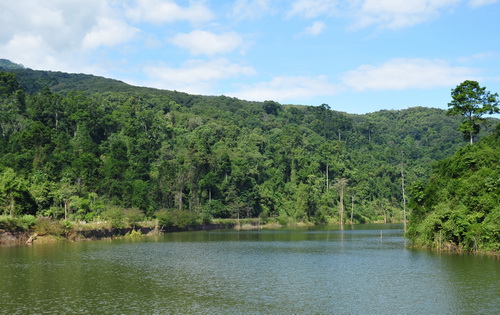Species spatial distribution patterns are shaped by underlying community assembly processes. Evidence for traits influencing community structure through habitat association is strong, but still coarse. Previous studies have laid the groundwork for a higher resolution of the drivers of habitat associations.
Researchers from Xishuangbanna Tropical Botanical Garden (XTBG) and University of California Los Angeles conducted a study in the 20-ha tropical forest dynamics plot to test hypotheses about the trait and environmental drivers in tropical forest communities. The researchers sampled traits that characterize drought tolerance and water use as well as quantitative environmental variation to test hypotheses about the trait and environmental drivers of habitat associations in the 20-ha forest plot. They measured physiological and functional traits for 3-6 saplings (dbh ranged from 1 to 10 cm) of 43 evergreen species.
They sampled the turgor loss point (πtlp), a key drought tolerance trait that represents leaf vulnerability to wilting, and sapwood area- and leaf area-specific stem conductivity (KS and KL), physiological traits contributing to the capacity to transport water to sustain transpiration and photosynthetic carbon gain. They also sampled the commonly-measured leaf structural and economic spectrum traits leaf dry mass per area (LMA), leaf density (ρ), leaf dry matter content (LDMC), and nitrogen concentration per unit mass (Nmass).
They distinguished for the first time between a signature of trait influence on habitat associations and competition (niche-based and hierarchical) using statistical methods that separated neighborhood from larger-scale spatial patterns, by implementing a wavelet transform of tree coordinates to produce analytically tractable functions for the correlation between two species’ points at given distances.
The study found that species' drought tolerance and habitat variables related to soil water supply were strong drivers of habitat associations, and drought tolerance showed a significant spatial signal for influencing competition. The drought tolerance trait leaf wilting point produced the only signal for both competition and habitat association, providing the first demonstration that leaf drought tolerance plays a critical role in multiple assembly processes in tropical communities.
The study entitled “Drought tolerance as a driver of tropical forest assembly: resolving spatial signatures for multiple processes” has been published online in Ecology. 
The 20-ha forest plot in Xishuangbanna (Image by LIN Luxiang) Key Words
Tropical forest, functional traits, drought tolerance, environment, habitat association Contact
Megan Kathleen Bartlett Ph.D
Key Laboratory of Tropical Forest Ecology, Xishuangbanna Tropical Botanical Garden, Chinese Academy of Sciences, Mengla, Yunnan 666303, China
E-mail: mkbartl@gmail.com |

